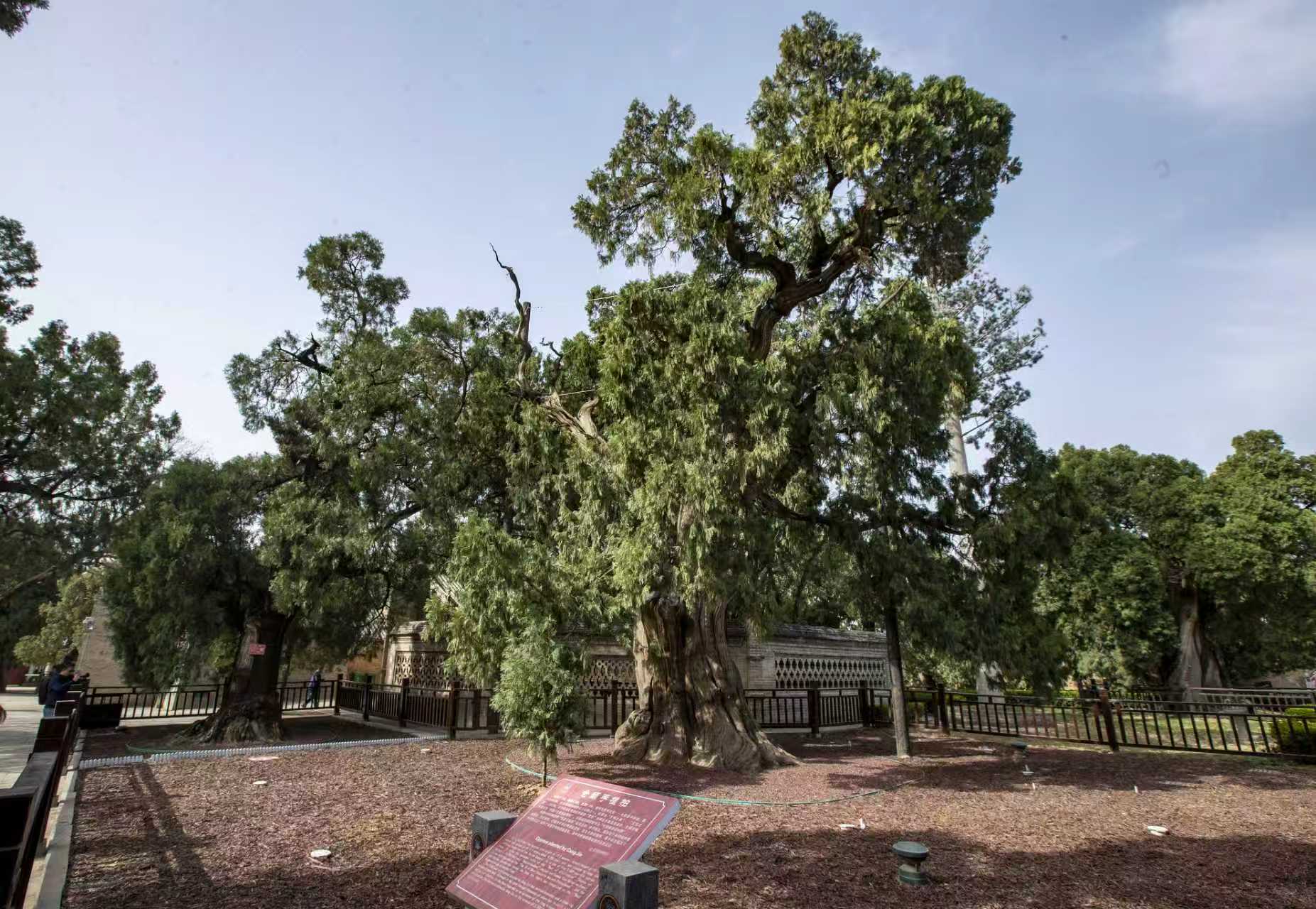Millennium-old cypresses carry culture across generations
2025-10-17 15:20:36 来源:人民网 

Photo shows ancient cypresses in the Cangjie Temple. (Photo/Peng Yipeng)
Enter the Cangjie Temple in Baishui county, Weinan, northwest China's Shaanxi province, and an imposing cypress immediately commands attention. Its trunk is so broad that five or six people could barely encircle it. Its weathered bark drapes in ribbons, the varied striations reading like a record of time.
This is the cypress planted by Cangjie, the legendary creator of Chinese characters. Standing 16 meters tall, with a diameter at breast height of 2.48 meters and a ground-level circumference of 9.9 meters, the tree has taken root on the Loess Plateau for about 5,000 years.
Ancient cypresses are scattered throughout the temple grounds, each bearing deep historical weight. "There are more than 40 cypresses over 1,000 years old here, with an average age of around 3,000 years. In addition to the 5,000-year-old Cangjie cypress, three are over 4,000 years old and 14 are more than 3,000," said tour guide Liang Ni, pointing out the giants one by one.
China's second national survey on ancient and famous trees reports that Shaanxi has more than 727,000 such trees, including over 11,000 solitary specimens and 271 groves totaling about 716,000.
In the autumn breeze, the cypresses rustle like ancient storytellers. Tradition holds that Cangjie served as historian for the legendary ancestor Huangdi, or the Yellow Emperor, and when knot-tying could no longer meet the demands of increasingly complex affairs, created the earliest Chinese characters. This cypress is said to have been planted by his hand. Visitors pause beneath it, run their fingers over the rough bark, study the distinctive grain, and marvel at the millennia it embodies.
To safeguard these treasures, local authorities have put comprehensive protections in place. In 2019, Weinan adopted the Regulations on the Protection of the Cangjie Tomb and Temple, bringing the temple's cypresses under legal protection. A regulation on the protection of ancient and famous trees further strengthened these conservation efforts.
Technology offers more intelligent ways to preserve the trees. A detailed record has been created for the cypress planted by Cangjie, documenting its physical condition, maintenance measures, and growing environment, and connecting it to a real-time monitoring platform shared across national, provincial, municipal, and county levels. A panel of leading experts in ancient tree and cultural-relic conservation conducts regular checkups, forming a "one tree, one team" model that combines expert guidance, county supervision, and responsible caretakers."
"With digital monitoring, we can track the cypress's growth in real time. If we see yellowing leaves or abnormal bark, the expert team comes promptly to diagnose and carry out rejuvenation measures," said Li Min, deputy head of the Cangjie Temple Cultural Relics Administration.
While preservation continues, efforts are also made to pass on the cultural heritage embodied by these ancient trees. Every year around Grain Rain, or "Guyu" in Chinese, a solar term to mark the end of spring that coincides with the UN Chinese Language Day, the temple hosts cultural events commemorating Cangjie. Under the shade of ancient cypresses, young visitors try woodblock printing, watching character strokes take shape at their fingertips and experiencing the appeal of tradition. Exhibition rooms with images, texts, and artifacts invite visitors to learn about the origins and evolution of Chinese characters while they admire the trees.
This five-millennia-old cypress bridges past and future. In spring 2012, a young sapling was discovered growing beneath the ancient cypress. "It proves the Cangjie cypress can reproduce naturally from its seeds. Thirteen years on, it's thriving," said Ren Zhigang with the temple administration. "Seeing such vigor prompted us to explore space breeding to extend its fine genetic line."
In early 2020, local authorities partnered with the Shaanxi provincial space breeding engineering technology research center to explore space-based propagation. "Space breeding provides a new technological pathway for conserving and revitalizing the genetic resources of the Cangjie cypress," Ren explained. "The offspring may be more vigorous and resilient, which is significant for preserving the variety."
In May that year, seeds collected from the ancient cypress embarked on a space journey aboard a Long March rocket. Today, at the Cangjie Cypress Breeding Base in Baishui county, "space-bred" seedlings are unfurling tender green shoots. Some have already been transplanted back to the temple, carrying forward the genetic legacy of their 5,000-year-old ancestor.
编辑: 马路遥
 以上文章仅代表作者个人观点,本网只是转载,如涉及作品内容、版权、稿酬问题,请及时联系我们。电话:029-63903870
以上文章仅代表作者个人观点,本网只是转载,如涉及作品内容、版权、稿酬问题,请及时联系我们。电话:029-63903870